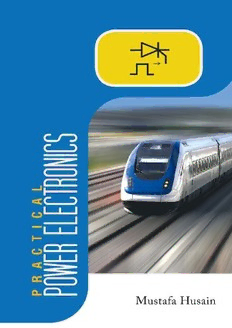
Practical Power Electronics. Applications, Experiments and Animations PDF
Preview Practical Power Electronics. Applications, Experiments and Animations
PRACTICAL POWER ELECTRONICS APPLICATIONS, EXPERIMENTS AND ANIMATIONS MUSTAFA HUSAIN Copyright © 2015 by Mustafa Husain. ISBN: Hardcover 978-1-4828-5464-0 Softcover 978-1-4828-5463-3 eBook 978-1-4828-5465-7 All rights reserved. No part of this book may be used or reproduced by any means, graphic, electronic, or mechanical, including photocopying, recording, taping or by any information storage retrieval system without the written permission of the author except in the case of brief quotations embodied in critical articles and reviews. Because of the dynamic nature of the Internet, any web addresses or links contained in this book may have changed since publication and may no longer be valid. The views expressed in this work are solely those of the author and do not necessarily reflect the views of the publisher, and the publisher hereby disclaims any responsibility for them. www.partridgepublishing.com/singapore CONTENTS Preface PART I THEORY 1 Introduction 1.0 Objectives 1.1 History of Power Electronics 1.2 Classification of Power Electronics 1.3 Converters 1.4 Applications 2 Devices 2.0 Introduction 2.1 PN-Junction Diode 2.2 Thyristors 2.2.0 Silicon Controlled Rectifier (SCR) 2.2.1 Gate Turn Off (GTO) 2.2.2 Triode AC (TRIAC) 2.2.3 Light-Activated Devices 2.2.4 Thyristor Firing and Protection Circuits 2.2.5 Unijunction Transistor (UJT) 2.2.6 Diode AC (DIAC) 2.2.7 Protection Against di/dt and dv/dt 2.3 Bipolar Junction Transistors (BJT) 2.3.0 NPN Transistor 2.3.1 Darlington Transistor 2.4 MOSFET 2.5 Insulated Gate Bipolar Transistor (IGBT) 3 Diode Rectifiers 3.0 Introduction 3.1 Half-Wave Rectifier 3.2 Full-Wave Rectifier 4 Thyristor Rectifiers 4.0 Introduction 4.1 Half-Wave Rectifier 4.2 Full-Wave Rectifier 5 Inverters 5.0 Introduction 5.1 Applications Of Inverters 5.2 Half-Bridge Inverter 5.3 Bridge Inverter 5.4 Uninterruptible Power Supply (UPS) 6 Choppers 6.0 Introduction 6.1 Step-Down Chopper 6.2 Step-Up Chopper 6.3 Step Up/Down Chopper 7 Single-Phase Voltage Regulators 7.0 Introduction 7.1 Phase-Angle Control 7.2 On-Off Control 7.3 Commercial Application 8 Understanding Data Sheets 8.0 Introduction 8.1 The Diode 8.2 The Thyristor 8.3 The BJT 8.4 The MOSFET 8.5 The IGBT Part II Experiments Experiment 1 Testing of Power Electronic Devices 1.0 Objectives 1.1 Equipment 1.2 Discussion 1.3 Testing of Semiconductor Switches 1.3.1 Diode 1.3.2 SCR Experiment 2 Characteristics of PN-Junction Diode 2.0 Objectives 2.1 Equipment 2.2 Discussion 2.3 Experiment 2.3.0 Forward Bias 2.3.1 Reverse Bias Experiment 3 Uncontrolled AC-DC Converter 3.0 Objectives 3.1 Equipment 3.2 Discussion 3.3 Experiment 3.3.0 Half-Wave Rectifier 3.3.1 Full-Wave Rectifier Using Discrete Diodes 3.3.2 Full-Wave Rectifier Using Bridge Rectifier Chip Experiment 4 Controlled AC-DC Converter 4.0 Objectives 4.1 Equipment 4.2 Discussion 4.3 Experiment Experiment 5 DC-DC Converter 5.0 Objectives 5.1 Equipment 5.2 Discussion 5.3 Experiment 5.3.0 Step-Down Chopper Experiment 6 AC-AC Converter 6.0 Objectives 6.1 Equipment 6.2 Discussion 6.3 Experiment 6.3.0 Phase-Angle Control Method 6.3.1 On-Off Control Method DATA SHEETS In memory of late Elbaz Ayad Work. Finish. Publish. Michael Faraday (1791-1867) PREFACE Why another book on power electronics? It is not just another book. Most of the published books in this area focus on the design aspects and they are full of mathematics that distracts the learners from understanding the operating principles which practicing engineers and technicians need in their daily jobs. Moreover, when it comes to experiments, the available books are scarce. We know of many electrical engineering graduates who passed a power electronics course but, when they joined the industry, they saw a big gap between what was taught and what knowledge and skills the industry needs. For instance in a power electronics course, all graduates should know the symbol, operation and applications of the thyristor. But many of them might not touch or see the physical appearance of the thyristor nor might they see industrial applications of the thyristor. This would be quite a shock if these graduates caught jobs that happen to involve the operation and maintenance of thyristors in big systems. How can we prepare learners for such jobs? This book aims to be the first step in narrowing the gap between academia and industry. It is an organized collection of useful notes that we have used for 15 years to teach the basics of power electronics theoretically and practically. We let our students touch and feel power electronics. We do practical demonstrations and we dismantle appliances and panels to show them the physical appearances of devices and controllers that work together to form a power electronics converter. We have different shapes and sizes of devices and converters manufactured by a variety of global designers. In addition, we organize industrial visits to see the applications and operation of power electronics. Instructors are strongly advised to carry with them power electronic devices and show them to their classes and also to give their students the opportunity to touch and feel the devices. It is wise to keep these notes in a book and it is a pleasure to share them with interested instructors and professionals worldwide. Being concise, it aims to explain the basic operating principles briefly and to present some applications of power electronics without deep explanation. The book is divided into two parts; theoretical and experimental. The first part consists of eight chapters covering the operation of devices and circuits. The basic converters are ac-dc, ac-ac, dc-ac and dc-dc converters. Some applications of these converters are listed and some are briefly explained. The second part has six experiments that will help the learner have the feeling of power electronics and to understand the concepts practically. Included also is the employment of microcontrollers to provide simple control of converters. To assist the learner further, photos of power electronic devices and circuits of some gadgets and appliances that we use daily are included. The text is enriched with simple diagrams. For easier and quicker understanding, some concepts were animated. The animations are available on EduMation.Org, a website dedicated for educational animations. The animations may also be found on the EduMation channel on YouTube. Data sheets of power electronic devices are attached at the end of the book.
